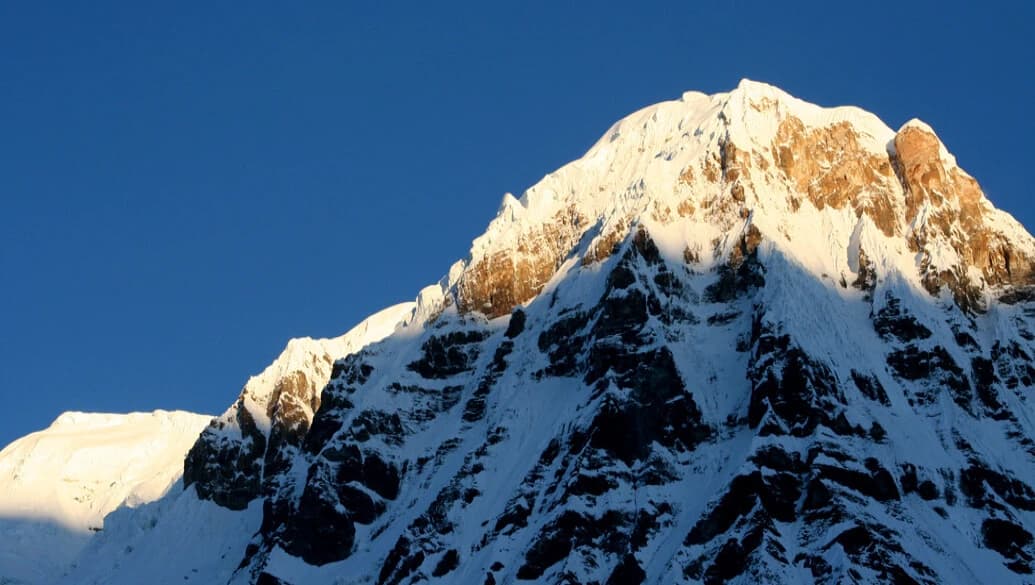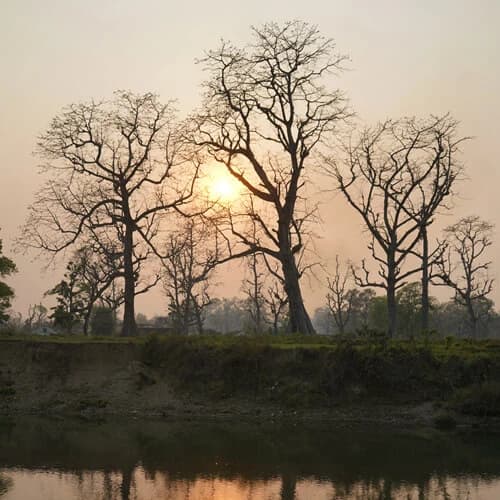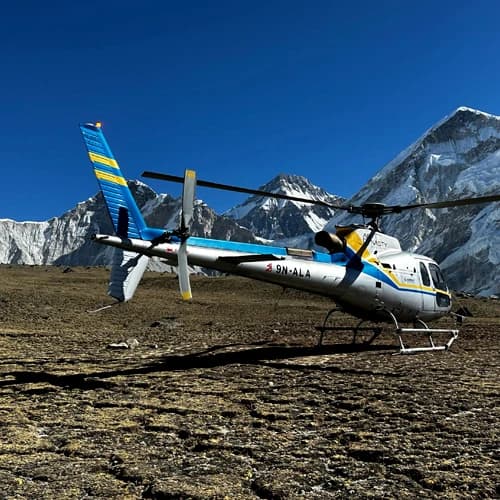Hiunchuli Peak Climbing is a popular Nepalese hiking peak. Mount Hiunchuli (6441m) is Nepal's fourth-tallest peak. Although it is one of the easier peaks in the Annapurna range for climbers, it is susceptible to rock falls. Because of the lack of publicity, mountaineers have paid little attention to the peak and are rarely ascended. Hiunchuli peak is technically easy to ascend and is best suited for novice climbers.
Hiunchuli Peak, like the other two Annapurna summits Tent Peak and Singu Chuli, is embedded in the Annapurna range. The Gurung ethnic group considers Hiunchuli Peak to be a sacred mountain. It is accessible from both the southeast and northwest faces. The summit was first climbed by the southeast face by an American Peace Corps Expedition team in October 1971.
There are two ways to ascend Hiunchuli Peak. The South-East Face Route, which begins at Hinko cave on the Annapurna Sanctuary or base camp trail, and the North-West Face Route, which is regarded as a challenging route with only a few climbers having attempted it. The approach is from the Annapurna Base Camp, and the exact path is unknown. The Gurung ethnic group is the majority in the region.
Join Outfitter Nepal’s 20-day of Hiunchuli Peak Climbing expedition and prepare yourself for the ultimate adventurous journey! Our Hiunchuli Peak Climbing excursion is filled with activities that will keep your adventurous spirit alive! We have decades of mountain experience that we have put into the planning of the peak climbing itinerary. Make a reservation for one of our departure dates to start customizing your own!
Hiunchuli Peak Route
The 20 days Hiunchuli peak route follows the classic Annapurna Base Camp trail, thus, this allows you to visit one of the world’s most famous trekking trails as a side conquest! Your journey starts with a drive from Kathmandu to Pokhara, which takes about 6 hours. From Pokhara, you drive to Nayapul and start your trekking from here. Within the next few days of trekking, you pass by Tadapani, Chhomrong, Dovan, and Deurali and finally reach Annapurna Base Camp.
We have made sure to add in many acclimatization days as possible. From the base camp of Annapurna, we trek towards Hiunchuli Base Camp and have an overnight at the tented camp there. From the Hiunchuli base camp, we move towards the high camp. You summit Hiunchuli from the high camp and return to the Annapurna Base Camp. Now, the journey descends you to Dovan, then Jhinudanda, Pothana and Dhampus Phedi respectively. From Dhampus Phedi, you have a short drive to Pokhara and then you get back to Kathmandu. This way, your Hiunchuli Peak expedition is accomplished.
Hiunchuli Peak Grade
Hiunchuli Peak is the trekking peak enlisted on the NMA (Nepal Mountaineering Association). The French/ Swiss Alpine Climbing System rates the ascent to Hiunchuli Peak as PD + (Per Difficulty). Climbing on ice and snow is a straight ascent that involves some technical labor, with a sharp rise to the summit.
Hiunchuli Peak in Autumn and Spring
Hiunchuli Peak is best explored in the spring (March-May) and autumn (September-November) (September-November). Because of the mild temperatures, clear skies, and little snowfall, the summit is a lovely place to visit. In addition, during the post- and pre-monsoon seasons, Annapurna's rain-free days are ideal for day treks and sightseeing.
Hiunchuli Peak in September
The typical temperature is between 0 and 15 degrees Celsius, with bitterly cold nights. The Himalayas will, however, be more visible because the days are bright and sunny. Hikers may become soaked if it rains, particularly in early September. As a result, you'll need to use caution even if you're climbing Hiunchuli Peak in September.
Hiunchuli Peak in October
Because the precipitation will be lesser and the sky will be clear in October, our mountain vista will be enhanced. Mountain ranges like as Dhaulagiri, Annapurna range, Gangapurna, Lamjung Himal, Nilgiri, Manaslu, Himchuli, Machhapuchhre, and others may be visible.The forest will be deep, the settlement will be green, and numerous flowers will bloom as a result of the rain, giving you a gorgeous image that will be ideal for photographing.
Hiunchuli Peak in November
November, a popular trekking month, brings pleasant weather to most of the sites. On a Hiunchuli Peak Climb, this is almost a given. The days are bright and sunny in November. The sky is clear, with perhaps a few stray clouds possible. The weather is cold, ranging from 12 to 17 degrees Celsius. The average temperature lowers to 7 degrees Celsius at night. The last days of November are a little chilly as winter approaches.
Hiunchuli Peak in March
Spring is another beautiful season to plan for your Hiunchuli Peak ascent. Highs of 17 degrees Celsius will be the norm from now on. The nights are cooler and more humid across the region after the lowest temperature of -15 degrees Celsius. The mornings are bright and sunny, while the afternoons are breezy and cold.
Hiunchuli Peak in April
In April, the days are mainly sunny, and the temperatures are slowly rising. Evenings and evenings are pleasant, though not as pleasant as March. Hiunchuli Peak's daytime temperatures range from 0 to 15 degrees Celsius, making it a suitable climbing destination.
Hiuchuli Peak in May
In May, daytime temperatures reach 20 degrees Celsius and nighttime temperatures reach 5 degrees Celsius. Before May, temperatures could drop below freezing during the night. Rhododendrons, Poinsettias, Orchids, and a variety of other flowers bloom during this time of year. Because the weather is always favorable, this is one of the best times to climb the Hiunchuli peak.
Hiunchuli Peak during Monsoon (June – August) and Winter (December – February)
The Hiunchuli climb may be completed at any time of year, but it is particularly difficult during the monsoon and winter months. During the monsoon, the course becomes particularly muddy due to the erratic weather pattern and heavy rainfall. It is not, however, impossible. Guests of Outfitter Nepal have climbed the summit even during the wet months of June and July. However, you may need to bring extra gear to ensure your safety on the ice hill. Winter is similarly harsh and unforgiving. The ascent can be difficult due to piles of snow and the harsh cold! As a result, the optimum times to climb Hiunchuli in the Himalayas are in the spring and winter.
Hiunchuli Peak Climbing Cost
The cost of Outfitter Nepal’s 20 days Hiunchuli Peak Climbing package ranges from US$ 1900 to US$ 2500 depending upon the number of people going on the excursion. If you are a group of 9 to 12, then the cost can get as low as US$1900, while for a group of 5 to 8 and 2 to 4, the cost goes to be around US$ 2100 and US$ 2300 respectively. Similarly, if you are a solo trekker, your package cost is around US$ 2500. Please note that the cost of the itinerary can be customized to fit your needs, however, these are the standard cost to maintain modest hospitality during your food and accommodation. If you want to extend your length of stay, we can easily manage it. Please know that any alteration in the itinerary would also change the cost of the package.
Difficulty in climbing the Hiunchuli Peak
The Hiunchuli Peak is rated to be strenuous, thus, you require some level of fitness and experience for climbing this peak. Climbing up through the foot of the headwall will be the most difficult portion. However, you will be safe if you make the necessary preparations and draw safety lines. You can reach the summit ridge if you have a strong enough determination. From there, the ascent is simple and quick to the peak.
If you do not maintain proper hygiene and safety, climbing will not be suitable for you. Thus, you must be responsible for your safety while mountaineering. Planning more days on this expedition will make the ascent simpler. In addition, this excursion will include 2-3 days of acclimatization.
Altitude Sickness during Hiunchuli Peak Ascent
The deficiency of oxygen in the blood and tissues at a high altitude causes altitude sickness, which is a common health impact. It happens when you travel at a high rate at a high altitude. It occurs due to low oxygen levels in the air and your blood. Altitude sickness can cause nosebleeds and nausea. Headaches, vomiting, exhaustion, insomnia, and dizziness are among the symptoms.
Food and Accommodation
You get to stay in tourist-friendly hotels and tea-houses during the trek. The rooms are smaller than you are typically used to, yet cozy! You get to use WI-FI services wherever possible. There are basic attached washroom facilities with hot shower services as well. You also get to experience what it is like to live inside a tent in the middle of the Himalayas, so that’s something to look forward to!
In the hotels and teahouses through the trail, you get a variety of dishes on the menu! There are noodles, sandwiches, burgers, pizzas and many more. However, we encourage you to try local Nepali cuisines such as “Dal Bhat” as it is a balanced diet full of nutrients!
Travel Insurance
Most of the dangers involved with trekking in Nepal can be covered by travel insurance. Travel insurance not only protects you against the risks of traveling in any country but also ensures that you have a stress-free trip to Nepal. Emergency medical evacuations, baggage loss, and travel cancellations are all covered under the coverage. Make sure that you get travel insurance that covers more than 6000m for your climb in Hiunchuli Peak.
Essential Gears for your Hiunchuli Peak Climb
This is the list you particularly require for the Hiunchuli Peak Ascent.
- Hand Wears: Gloves and Hand warmers
- Footwear: Trekking Shoes, Altitude Liner, Woolen socks, Trekking Socks
- Personal Equipment: Trekking Backpacks, Toiletry Bags, Gears
- Climbing Gears: Ice Ax, Climbing Harness, Crampons, Karabiners, Belay Device, Ascender
- Mountaineering Boots and Helmet
- Ropes
- Ice Crews




